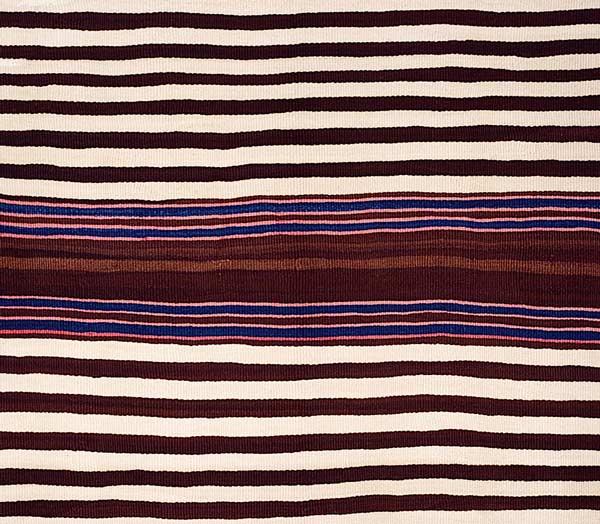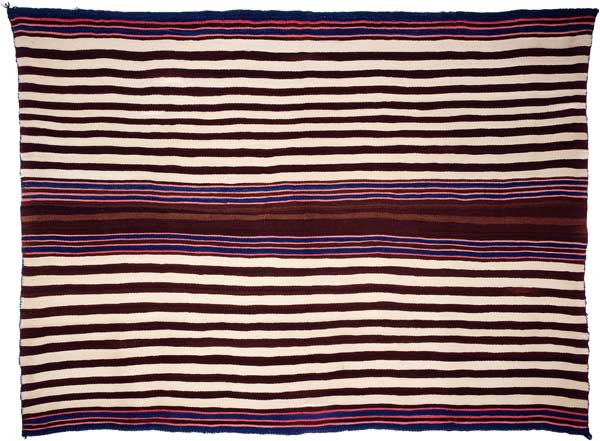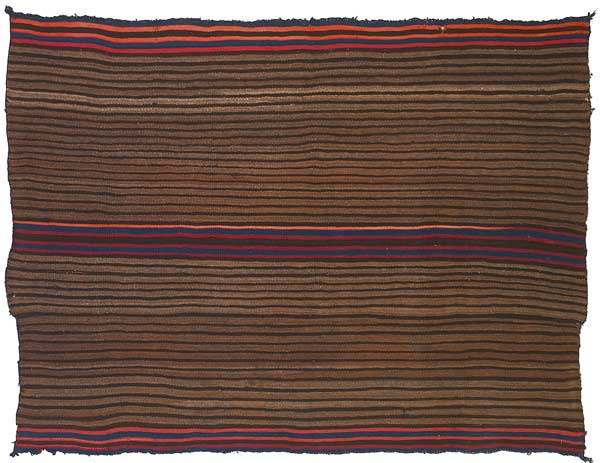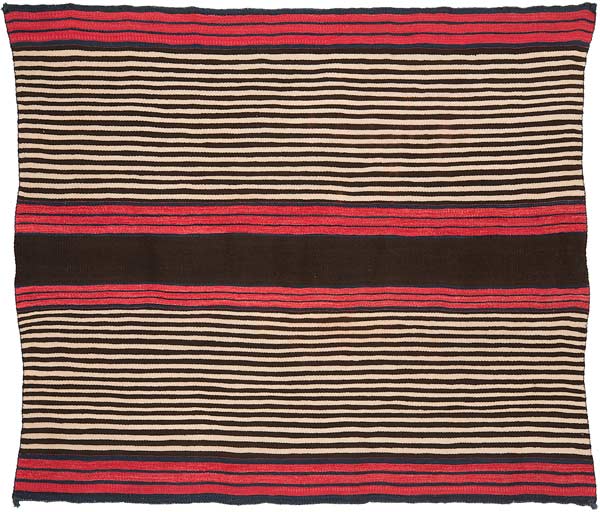#8. A Classic Bayeta First Phase Chief’s Blanket, Woman’s Style, Navajo, circa 1855, also known as the Buffaloe Bayeta First Phase. The first phase measures 46 inches long by 57 inches wide, as woven.
There are twenty-two classic (pre-1865) bayeta first phase chief’s blankets, woven in both the man’s and the woman’s style. Fourteen were woven in the man’s style; eight in the woman’s style. The Buffaloe Bayeta First Phase is one of the eight classic bayeta first phases woven in the woman’s style, and one of two bayeta first phases, woman’s style, with alternating brown and white stripes above and below its central panel.
In 2012, when the Chantland Bayeta First Phase sold at auction, for $1,800,000, the art world took notice. The sale established classic bayeta first phases woven in the man’s style as Navajo blankets of rarity and value. A classic bayeta first phase woven in the woman’s style has never sold at auction. Bayeta first phases woven in the woman’s style are so rare, many art collectors have no idea that they exist.
The first phase is ex- Thom Buffaloe, of Mancos, Colorado. Between 1975 and 1995, Thom Buffaloe was a prominent collector and dealer of classic Navajo blankets and historic Pueblo pottery. Buffaloe was also an accomplished aviator, with interests in aircraft leasing companies, antique planes, and backcountry aircraft. During the early 2010s, Buffaloe and his wife, Rosalind, built a house on an old hay ranch outside of Mancos, Colorado, with an airplane hangar and a runway adjacent to the house.

The center of the Buffaloe Bayeta First Phase,
Woman’s Style, Navajo, circa 1855.
In the Buffaloe Bayeta First Phase, 90% of the medium red and pale red yarns are raveled bayeta piece-dyed with cochineal. 10% of the red yarns are European three-ply machine-spun knitting yarns, also known as Saxony yarns, dyed in the skein with cochineal. The Saxony yarns match the color of the first phase’s medium red raveled bayeta.
The blue yarns are handspun Churro fleece dyed in the yarn with indigo. Each of the first phase’s eight blue bands shows deep color variegation.
The dark and light brown yarns are un-dyed handspun Churro fleece, carded and spun from at least two different un-dyed brown fleeces. The light brown handspun yarns appear in a single horizontal band that runs through the upper center of the first phase’s dark brown central panel.
The white yarns are un-dyed handspun Churro fleece. The white yarns’ ivory color matches the ivory color of the un-dyed white handspun yarns in the Chantland Bayeta First Phase and the Woodhouse Bayeta First Phase.

A Classic Bayeta First Phase Chief’s Blanket, Navajo circa 1840, also known as the Chantland Bayeta First Phase. The first phase was collected in 1870 by John Chantland, the Postmaster of Mayville, North Dakota. The first phase remained in Chantland’s family for the next one hundred and fifty years. The first phase measures 58 inches long by 68 inches long, as woven.
On June 19, 2012, the Chantland Bayeta First Phase sold for $1,800,000, buyer’s premium included, at John Moran’s Auctioneers in Pasadena, California. As of April, 2023, $1,800,000 stands as the auction record for a Navajo blanket. The buyer was the Donald Ellis Gallery, of New York.
In 2016, the Chantland Bayeta First Phase was sold by the Donald Ellis Gallery to Valerie and Charles Diker, of New York. Between 2018 and 2021, the Chantland Bayeta First Phase was on exhibit in the American Wing at the Metropolitan Museum of Art in New York, by loan from the Dikers.
Due to its record price at auction, and to its exhibition at the Metropolitan Museum, the Chantland Bayeta First Phase is one of two classic first phases that qualify as candidates for the most famous first phase chief’s blanket in the world. The other candidate is the Berlant First Phase.
The brown and white bands in the field above and below its central panel qualify the Chantland Bayeta First Phase as a classic first phase woven in the man’s style. Classic first phases woven in the woman’s style have fields of thin, alternating stripes above and below their central panels.
In the Chantland Bayeta First Phase, the red yarns are raveled bayeta piece-dyed with lac. The blue yarns are handspun Churro fleece dyed in the yarn with indigo. The brown yarns and the white yarns are both un-dyed handspun Churro fleece.


Above: The Buffaloe Bayeta First Phase, Woman’s Style, Navajo, circa 1855.
The first phase measures 46 inches long by 57 inches wide, as woven.
Below: The Chantland Bayeta First Phase, Man’s Style, Navajo, circa 1840.
The first phase measures 58 inches long by 68 inches long, as woven.

A Classic Bayeta First Phase Chief’s Blanket, Navajo, circa 1850, also known as the Woodhouse Bayeta First Phase. The first phase measures 71 inches wide by 51 inches long, as woven.
The Woodhouse Bayeta First Phase was collected in 1851, at Zuni Pueblo, by Samuel Woodhouse, an American ornithologist and surgeon. Woodhouse acquired the first phase in mint condition. This raises the possibility that he bought it off the loom from the Navajo woman who wove it. The first phase is the earliest bayeta first phase with documented collection history. The first phase is in the collection of the National Museum of the American Indian, Smithsonian Institution, in Washington, DC., and is on display at the Museum. [NMAI #11.8280].
The brown and white bands in the field above and below its central panel qualify the Woodhouse Bayeta First Phase as a classic bayeta first phase woven in the man’s style.
In the Woodhouse Bayeta First Phase, the red yarns are raveled bayeta piece-dyed with lac. The blue yarns are handspun Churro fleece dyed in the yarn with indigo. The brown yarns and the white yarns are both un-dyed handspun Churro fleece.


Above: The Buffaloe Bayeta First Phase, Woman’s Style, Navajo, circa 1855. The first phase measures 46 inches long by 57 inches wide, as woven.
Below: The Woodhouse Bayeta First Phase, Navajo, circa 1850. The first phase measures 71 inches wide by 51 inches long, as woven. The first phase was collected in 1851 at Zuni Pueblo by Samuel Woodhouse, an American ornithologist and surgeon. Woodhouse acquired the first phase in mint condition. It is the earliest bayeta first phase with a documented collection history.


Above: The Buffaloe Bayeta First Phase, Woman’s Style, Navajo, circa 1855.
Below: The Taylor First Phase, Ute Style, and Woman’s Style, Navajo, circa 1860.
The Buffaloe Bayeta First Phase’s medium and pale red stripes qualify it as a classic bayeta first phase, as opposed to a classic Ute Style first phase, which has no red stripes.
The Buffaloe Bayeta First Phase is one of two known examples of a classic bayeta first phase, woman’s style, with alternating brown and white stripes. All of the other classic first phases, woman’s style, including the Taylor First Phase, pictured above, have alternating brown and gray stripes in their fields. As one of two known examples of classic first phases, woman’s style, with alternating brown and white stripes in their fields, the Buffaloe Bayeta First Phase is a classic Navajo blanket of extreme rarity.


Above: The Buffalo Bayeta First Phase, Woman’s Style, Navajo, circa 1855.
Below: The Goodenough Red Line First Phase, Woman’s Style, Navajo, circa 1860.
The Goodenough Red Line First Phase is in the collection of the Museum of Natural History in New York, by donation from Sara Elizabeth Goodenough, in 1942. The first phase is illustrated as Plate 7 in Walk In Beauty. The Goodenough Red Line First Phase can’t really be called a bayeta first phase because it contains no raveled bayeta. Its red and coral pink stripes are both three-ply machine-spun knitting yarns. The Goodenough First Phase measures 43 inches long by 58 inches wide, as woven.
Among woman’s style first phases, the Goodenough Red Line First Phase’s field of alternating brown and gray stripes above and below its central panel is more common than the field of alternating brown and white stripes in the Buffaloe First Phase.

A Classic Bayeta First Phase Chief’s Blanket, Woman’s Style, Navajo, circa 1860, also known as the Manchester Bayeta First Phase. The first phase measures 44 inches long by 54 inches wide, as woven. The first phase qualifies as a candidate for the finest known classic (pre-1865) bayeta first phase woven in the woman’s style.
In the Manchester Bayeta First Phase, 90% of its red yarns are raveled Manchester bayeta piece-dyed with cochineal. “Piece-dyed” refers to the technique of lowering a large bolt of un-dyed woolen fabric into a vat of cochineal and dying the whole fabric red, as a piece. This is opposed to dying skeins of yarn in the yarn, as was the case with Saxony yarns.
Raveled Manchester bayeta tends to have a flecked appearance. The flecking is the result of unequal dye penetration by the cochineal used in dye vats at the woolen mills in Manchester, England, where English bayeta was woven and piece-dyed. 10% of the red yarns are European three-ply machine-spun knitting yarns, also known as Saxony yarns, dyed in the skein with cochineal. The Saxony yarns appear as a slightly more saturated red than the raveled Manchester bayeta.
The first phase was purchased in Boston, in 2016, by Joshua Baer & Company. In 2017, Joshua Baer & Company sold the first phase to the current owner.
In November, 2018, the first phase was exhibited as part of Agnes Martin / Navajo Blankets at Pace Gallery, Chelsea / New York.
The thin, alternating brown and white stripes above and below the central panel give the first phase a radiant quality. Initially, the twelve bands of raveled Manchester bayeta appear as foreground design elements. Then their flecked red color gives them a quality of atmospheric distance. This first phase’s combination of beauty, power, and restraint rarely appears in classic Navajo chief’s blankets, regardless of whether they were woven in either the man’s or the woman’s style.


Above: The Buffaloe Bayeta First Phase, Navajo, circa 1855.
Below: The Manchester Bayeta First Phase, Navajo, circa 1860.
These are the only known example of classic (pre-1865) bayeta first phases woven in the woman’s style with alternating brown and white stripes in the fields above and below their central panels. All of the other classic first phases woven in the woman’s style have alternating brown and gray stripes in the fields above and below their central panels.

The Buffaloe Bayeta First Phase, Navajo, circa 1855.
Bayeta first phases woven in the woman’s style are the rarest type of classic Navajo chief’s blankets. Their rarity is overlooked. The majority of collectors, dealers, and scholars who specialize in Navajo blankets have never seen a classic (pre-1865) bayeta first phase woven in the woman’s style. There are eight known examples of classic bayeta first phase woven in the woman’s style. Of those eight known examples, six have fields of brown and gray stripes above and below their central panels. Two have fields of brown and white stripes above and below their central panels.
The Buffaloe Bayeta First Phase has three red stripes in its top and bottom bands, and two opposing pairs of four red stripes in its central band. This is the same pattern of red stripes that appears in the Chantland Bayeta First Phase. The pattern suggests that the Buffaloe Bayeta First Phase was woven between 1850 and 1860. The combination of raveled red bayeta and red Saxony yarns in the Buffalo Bayeta First Phase supports the circa 1855 date.
In person, the Buffaloe Bayeta First Phase has an impulsive quality that does not appear in classic bayeta first phases woven in the man’s style. The alternating brown and white stripes above and below its central panel give the first phase a sense of perpetual motion. No matter how much time you spend with this first phase, it never stops moving.



